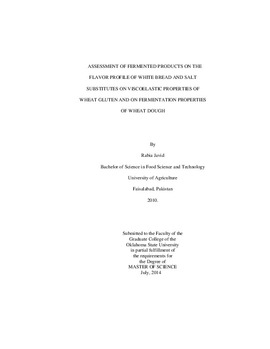| dc.description.abstract | Reduction of sodium chloride in daily intake has been received a lot of attention as increased consumption of NaCl is associated to cardiovascular diseases. NaCl plays an important role not only in improving the flavor of bread but also in rheological properties of wheat flour. Fermented products, sourdough and tempe flour (a fermented wheat/soy flour mixture) were used in formulation of bread. Both fermented products have the potential to increase the nutritional profile of bread by providing biological active compounds, vitamins and minerals and hydrolyzed protein, carbohydrate and lipids which help to improve the flavor and digestibility of bread. This study aimed to analyze the effect of fermented products on the flavor profile of white bread and rheological properties on dough. A commercial wheat flour (11% protein) was treated with sourdough (0, 11, 17 and 33%) tempe (0, 2, 3.5 and 5%) and NaCl (0, 0.5, 0.75, 1.0 and 1.5%) using a randomized complete block with three replications. In Study I, 5% tempe lowered the scores of flavor profile and 11% sourdough did not affect the sensory parameters. Tempe at 3.5% with 17% sourdough gave similar saltiness perception at 0.75 and 1.5% NaCl. Sourdough at 33% gave more pronounced effect on flavor profile than 17% sourdough. At 33% sourdough and 3.5% tempe, 2% NaCl increased the viscosity of gluten and decreased the elastic recovery. Sourdough at 33% and 3.5% tempe increased Hm, h, total volume, volume lost and volume retained and decreased T1 in dough fermentation properties. This was in part explained by the hydrolyzed wheat and soy proteins which interfered with gluten network formation and resulted in more viscous and less elastic dough. Study II aimed to analyze the effect of sodium chloride substitutes on dough rheological properties. Three commercial flours (9.8, 10.9 and 13.3% protein) were treated with 1 and 2% levels of salt substitutes using a randomized complete block with three replications. Results indicated that flour with 9.8% protein increased the viscosity of gluten with an increase in salt levels, whereas, flour with 13.3% protein did not show any significant effect on gluten viscoelastic properties with increase in salt level. Flour with 10.9% protein showed decrease in viscosity and increase in elastic recovery of gluten with increase in salt level. Salt substitutes at 1 and 2% increased Hm, total volume, volume lost and lower h and T1 values while increased viscosity of gluten and decreased elastic recovery with salt substitutes compared to controls. Reduced sodium salt substitutes affected gluten network formation and yeast activity which resulted in a negative effect on rheological properties of wheat flour compared to control (NaCl). | |
